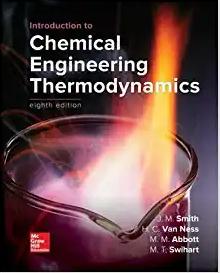Answered step by step
Verified Expert Solution
Question
1 Approved Answer
: Controlling static build up (a) Comment on how effective Panis is in controlling static build up. Note: You should support your answer, where applicable,
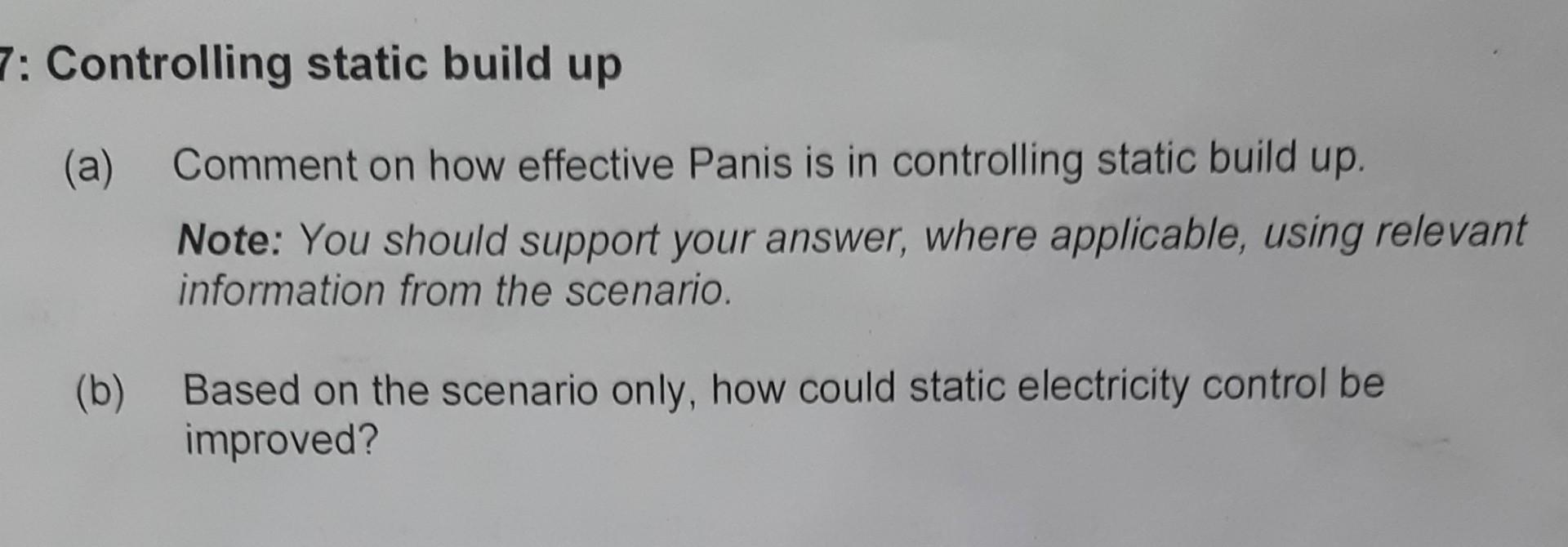


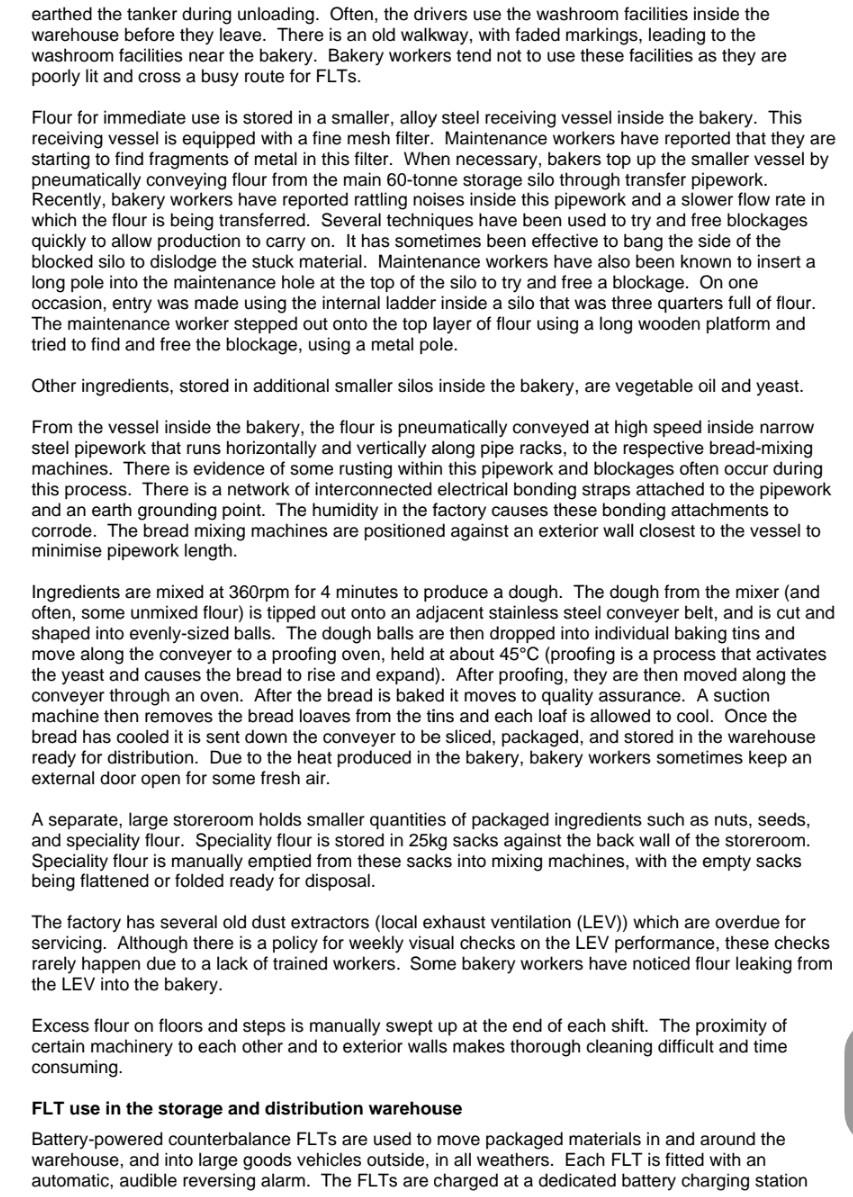
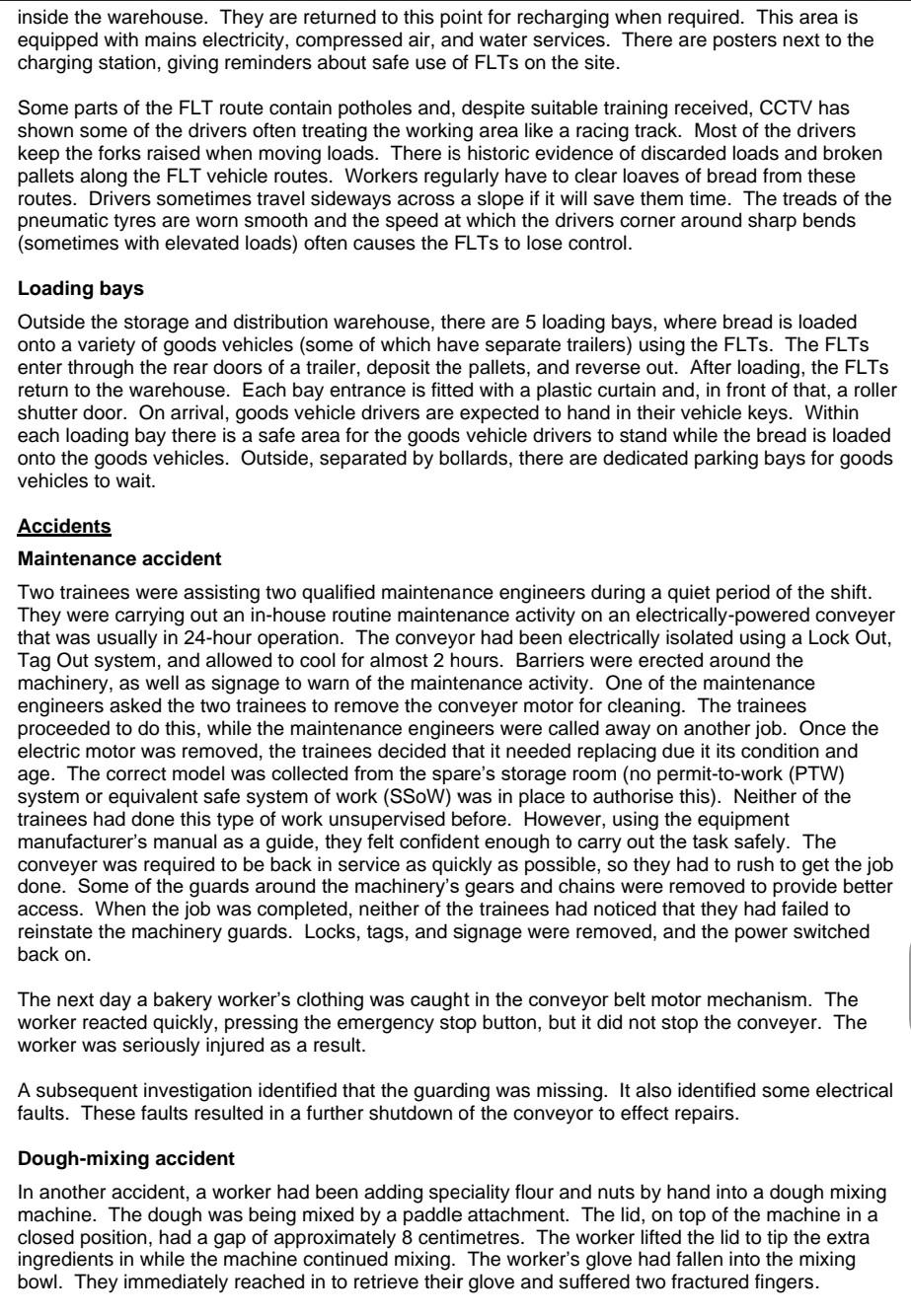
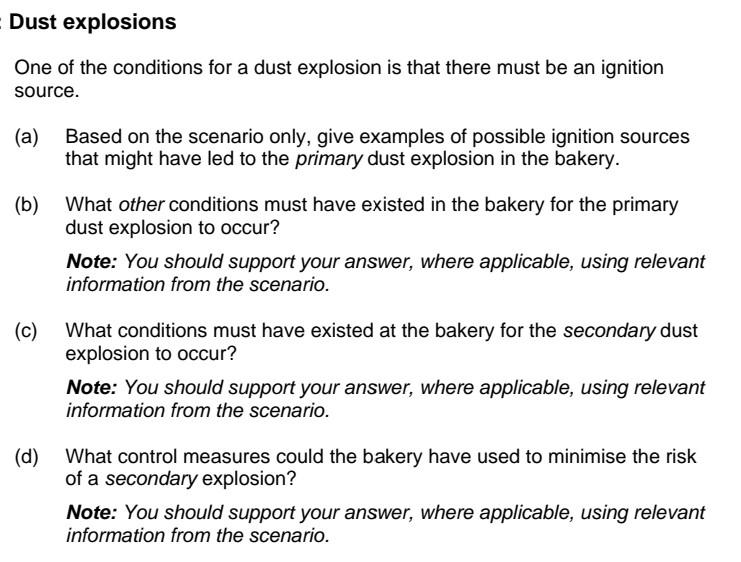
: Controlling static build up (a) Comment on how effective Panis is in controlling static build up. Note: You should support your answer, where applicable, using relevant information from the scenario. (b) Based on the scenario only, how could static electricity control be improved? : Controlling static build up (a) Comment on how effective Panis is in controlling static build up. Note: You should support your answer, where applicable, using relevar information from the scenario. (b) Based on the scenario only, how could static electricity control be improved? SCENARIO Panis is a food manufacturer that specialises in baking and distributing breads. It mainly supplies bread to supermarkets. It has operated from a large purpose-built site for 30 years. On the site are the following buildings: a bakery (where the bread is made), a storeroom (for packaged raw materials) and a storage and distribution warehouse (for the finished bread products). There are also silos near the entrance to the site (for bulk raw materials). Overhead piping, beams, and fluorescent lighting run across the bakery's low ceilings. The buildings are at the centre of a network of service roads crossing the site. Normal operation The organisation operates 24 hours a day, throughout the year. Workers are on a 2-shift rota system. The organisation employs 100 workers in various roles, such as office staff, production line workers, bakers, quality assurance staff, maintenance engineers, warehouse workers, and goods vehicle drivers. There are also trained first-aiders available on each shift. The busy storage and distribution warehouse prepares for several pickups daily by the goods vehicle drivers, usually in the very early hours of the morning. There is a one-way system in operation for all vehicles across the site. Panis workers and visitors must use a separate entrance and exit from the goods vehicles and silo tankers. Workers and visitors have a separate dedicated parking area. There is a straight road with traffic calming measures, such as speed humps, running through the site. Inside the warehouse, freshly baked bread is layered on pallets in steel racking. Racking is arranged in rows; each row is secured to the floor and is 10 metres ( 32 feet) long and 3 metres (10 feet) high. There are 8 parallel rows of racking, arranged in 4 back-to-back pairs. Aisles between each of the 4 pairs are narrow, with sufficient room to allow access for forklift trucks (FLTs). Sometimes the racking can become damaged when FLTs place the pallets on to them. There are signs at the entrance to the warehouse prohibiting access to visitors. Within the warehouse, pedestrians must keep to a clearly-marked walkway, and all workers must wear hivisibility clothing and hard hats. At one end of the warehouse is the entrance to the manufacturing area, and at the other end, are several loading bays where the bread pallets are loaded by the FLTs onto large goods vehicles. Several danger signs are placed around the warehouse warning of moving vehicles. Basic bread manufacture uses four main ingredients - flour, yeast, water, and salt. But the bakery also uses many other ingredients to make a range of different breads. The factory produces on average 200000 thousand loaves of bread per day. The bread making process goes through several stages, and on average takes 4 hours per batch. The process uses many different pieces of machinery made from stainless steel. Some of the older machinery is critical to the bread making process. Once regular maintenance and cleaning has been carried out on a machine, this is indicated with a red-coloured tag. Six electrically-earthed, vertical, 10 metre cylindrical steel vessels (silos) are each able to store up to 60 tonnes of flour and powdered sugar. Both ingredients are delivered in bulk 25 tonne loads, by silo tanker drivers via a dedicated road. Drivers are informed of the site layout before they arrive. Once the drivers arrive on site, they are expected to sign in and go straight to the unloading area. From here, the driver liaises with a bakery worker to unload the ingredient at a sheltered discharge point. The scheduled offloading operation usually takes around an hour. It uses a pneumatic conveying system, whereby compressed air (from an air compressor on the tanker) is used to dilute and blow the flour through connected pipework, directly to the main storage silo. This then passes through a coarsely painted steel cartridge filter into the main storage silo. Silo tanker drivers often want the transfer done quickly, due to time pressures. Despite training and clear signage on how to perform the task safely, drivers tend to increase the flour transfer rate. More recently, when left unsupervised by bakery workers, some of the drivers have not always electrically earthed the tanker during unloading. Often, the drivers use the washroom facilities inside the warehouse before they leave. There is an old walkway, with faded markings, leading to the washroom facilities near the bakery. Bakery workers tend not to use these facilities as they are poorly lit and cross a busy route for FLTs. Flour for immediate use is stored in a smaller, alloy steel receiving vessel inside the bakery. This receiving vessel is equipped with a fine mesh filter. Maintenance workers have reported that they are starting to find fragments of metal in this filter. When necessary, bakers top up the smaller vessel by pneumatically conveying flour from the main 60 -tonne storage silo through transfer pipework. Recently, bakery workers have reported rattling noises inside this pipework and a slower flow rate in which the flour is being transferred. Several techniques have been used to try and free blockages quickly to allow production to carry on. It has sometimes been effective to bang the side of the blocked silo to dislodge the stuck material. Maintenance workers have also been known to insert a long pole into the maintenance hole at the top of the silo to try and free a blockage. On one occasion, entry was made using the internal ladder inside a silo that was three quarters full of flour. The maintenance worker stepped out onto the top layer of flour using a long wooden platform and tried to find and free the blockage, using a metal pole. Other ingredients, stored in additional smaller silos inside the bakery, are vegetable oil and yeast. From the vessel inside the bakery, the flour is pneumatically conveyed at high speed inside narrow steel pipework that runs horizontally and vertically along pipe racks, to the respective bread-mixing machines. There is evidence of some rusting within this pipework and blockages often occur during this process. There is a network of interconnected electrical bonding straps attached to the pipework and an earth grounding point. The humidity in the factory causes these bonding attachments to corrode. The bread mixing machines are positioned against an exterior wall closest to the vessel to minimise pipework length. Ingredients are mixed at 360rpm for 4 minutes to produce a dough. The dough from the mixer (and often, some unmixed flour) is tipped out onto an adjacent stainless steel conveyer belt, and is cut and shaped into evenly-sized balls. The dough balls are then dropped into individual baking tins and move along the conveyer to a proofing oven, held at about 45C (proofing is a process that activates the yeast and causes the bread to rise and expand). After proofing, they are then moved along the conveyer through an oven. After the bread is baked it moves to quality assurance. A suction machine then removes the bread loaves from the tins and each loaf is allowed to cool. Once the bread has cooled it is sent down the conveyer to be sliced, packaged, and stored in the warehouse ready for distribution. Due to the heat produced in the bakery, bakery workers sometimes keep an external door open for some fresh air. A separate, large storeroom holds smaller quantities of packaged ingredients such as nuts, seeds, and speciality flour. Speciality flour is stored in 25kg sacks against the back wall of the storeroom. Speciality flour is manually emptied from these sacks into mixing machines, with the empty sacks being flattened or folded ready for disposal. The factory has several old dust extractors (local exhaust ventilation (LEV)) which are overdue for servicing. Although there is a policy for weekly visual checks on the LEV performance, these checks rarely happen due to a lack of trained workers. Some bakery workers have noticed flour leaking from the LEV into the bakery. Excess flour on floors and steps is manually swept up at the end of each shift. The proximity of certain machinery to each other and to exterior walls makes thorough cleaning difficult and time consuming. FLT use in the storage and distribution warehouse Battery-powered counterbalance FLTs are used to move packaged materials in and around the warehouse, and into large goods vehicles outside, in all weathers. Each FLT is fitted with an automatic, audible reversing alarm. The FLTs are charged at a dedicated battery charging station charging station, giving reminders about safe use of FLTs on the site. Some parts of the FLT route contain potholes and, despite suitable training received, CCTV has shown some of the drivers often treating the working area like a racing track. Most of the drivers keep the forks raised when moving loads. There is historic evidence of discarded loads and broken pallets along the FLT vehicle routes. Workers regularly have to clear loaves of bread from these routes. Drivers sometimes travel sideways across a slope if it will save them time. The treads of the pneumatic tyres are worn smooth and the speed at which the drivers corner around sharp bends (sometimes with elevated loads) often causes the FLTs to lose control. Loading bays Outside the storage and distribution warehouse, there are 5 loading bays, where bread is loaded onto a variety of goods vehicles (some of which have separate trailers) using the FLTs. The FLTs enter through the rear doors of a trailer, deposit the pallets, and reverse out. After loading, the FLTs return to the warehouse. Each bay entrance is fitted with a plastic curtain and, in front of that, a roller shutter door. On arrival, goods vehicle drivers are expected to hand in their vehicle keys. Within each loading bay there is a safe area for the goods vehicle drivers to stand while the bread is loaded onto the goods vehicles. Outside, separated by bollards, there are dedicated parking bays for goods vehicles to wait. Accidents Maintenance accident Two trainees were assisting two qualified maintenance engineers during a quiet period of the shift. They were carrying out an in-house routine maintenance activity on an electrically-powered conveyer that was usually in 24-hour operation. The conveyor had been electrically isolated using a Lock Out, Tag Out system, and allowed to cool for almost 2 hours. Barriers were erected around the machinery, as well as signage to warn of the maintenance activity. One of the maintenance engineers asked the two trainees to remove the conveyer motor for cleaning. The trainees proceeded to do this, while the maintenance engineers were called away on another job. Once the electric motor was removed, the trainees decided that it needed replacing due it its condition and age. The correct model was collected from the spare's storage room (no permit-to-work (PTW) system or equivalent safe system of work (SSoW) was in place to authorise this). Neither of the trainees had done this type of work unsupervised before. However, using the equipment manufacturer's manual as a guide, they felt confident enough to carry out the task safely. The conveyer was required to be back in service as quickly as possible, so they had to rush to get the job done. Some of the guards around the machinery's gears and chains were removed to provide better access. When the job was completed, neither of the trainees had noticed that they had failed to reinstate the machinery guards. Locks, tags, and signage were removed, and the power switched back on. The next day a bakery worker's clothing was caught in the conveyor belt motor mechanism. The worker reacted quickly, pressing the emergency stop button, but it did not stop the conveyer. The worker was seriously injured as a result. A subsequent investigation identified that the guarding was missing. It also identified some electrical faults. These faults resulted in a further shutdown of the conveyor to effect repairs. Dough-mixing accident In another accident, a worker had been adding speciality flour and nuts by hand into a dough mixing machine. The dough was being mixed by a paddle attachment. The lid, on top of the machine in a closed position, had a gap of approximately 8 centimetres. The worker lifted the lid to tip the extra ingredients in while the machine continued mixing. The worker's glove had fallen into the mixing bowl. Thev immediately reached in to retrieve their alove and suffered two fractured finaers. One of the conditions for a dust explosion is that there must be an ignition source. (a) Based on the scenario only, give examples of possible ignition sources that might have led to the primary dust explosion in the bakery. (b) What other conditions must have existed in the bakery for the primary dust explosion to occur? Note: You should support your answer, where applicable, using relevant information from the scenario. (c) What conditions must have existed at the bakery for the secondary dust explosion to occur? Note: You should support your answer, where applicable, using relevant information from the scenario. (d) What control measures could the bakery have used to minimise the risk of a secondary explosion? Note: You should support your answer, where applicable, using relevant information from the scenario
Step by Step Solution
There are 3 Steps involved in it
Step: 1

Get Instant Access to Expert-Tailored Solutions
See step-by-step solutions with expert insights and AI powered tools for academic success
Step: 2

Step: 3

Ace Your Homework with AI
Get the answers you need in no time with our AI-driven, step-by-step assistance
Get Started


